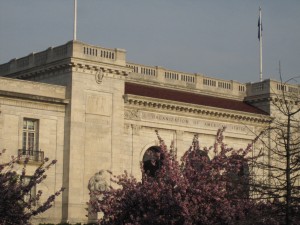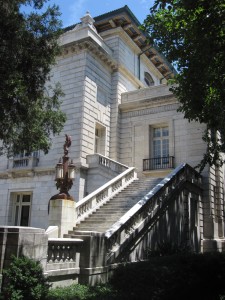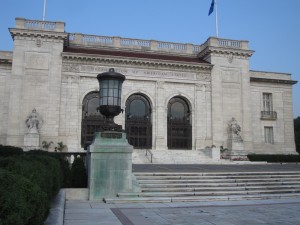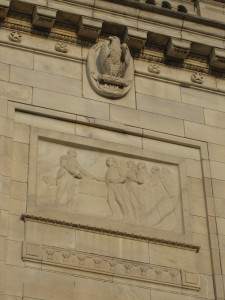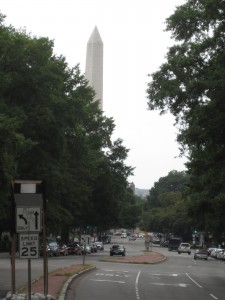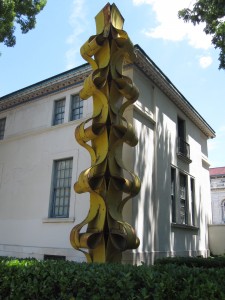With majestic oaks and elms a pedal-point, Virginia Avenue’s theme is the Americas. Look a little deeper to see other related themes: oppression, liberation, freedom, deeper, hidden melodies woven into this street’s song. Striking the first chord at the beginning of the walk, its corner touching the 1700 block of Virginia Avenue, is the House of the Americas, the lovely, impressive Beaux Arts headquarters of the Organization of American States. A visitor to Washington could easily miss this luscious little building. It took me a while to focus on it. The place has a distant feel, like the off-limits, gated and guarded estate of a famous person or an eccentric rich recluse. Besides not being readily noticeable, at least from Constitution Ave or Virginia, The House of the Americas must compete with its famous neighbors, the Washington Monument and the White House. What itinerary of D.C. includes the OAS headquarters? Plus it isn’t obviously public, though I have confirmed with someone who works there that it’s o.k. to wander around a bit. I have been on the grounds several times and discovered it’s not only public enough to be accessible but also well worth a little side trip off our main squeeze, Virginia Avenue, even though you’re barely twenty steps into the walk.
Through a gap in the hedge on your right, a gravel path leads into the Sculpture Garden, filled with art by American, mostly South and Central, artists. I was not initially comfortable with the fact that it’s o.k. to be walking around there. Since I discovered this area I’ve been back several times. No alarms sounded, nor did men in dark uniforms with big guns appear. Really. Go ahead and explore. It’s going to feel like you’re trespassing but you’re not. In fact, the place feels like someone should be glad a person has paused to see the sculptures and taken a few minutes to admire the building. The OAS may be a vital and important promoter of democracy and cooperation in the Americas, according to its own description, but the headquarters doesn’t feel that way. Walk a bit more through another hedge and you’re in the magnificent building’s garden. Pause to marvel at the building’s features, the sweeping staircases, the marble balustrades, the dentil molding along the roof line painted in the colors of the Americas, red, green, yellow.
Take a look at the empty pool and tile work in what they call the Aztec Garden, then work your way to the front. On your way, stop at each statue, busts of famous poets and writers such as the great Chilean poet, Pablo Neruda or the Venezuelan novelist, Teresa de la Parra. I like it that writers are honored here, that artists whose medium was words greet all who take the walk down Virginia Avenue.
Step around to the front of the building and soak in its facade, a collection of statues, carvings, and pretty but ostentatious decoration. Three huge brass arches dominate the view, though the actual entrance is a normal revolving door in the center. The right side of the facade, with an eagle and a carved scene of Washington’s farewell to his troops, is dedicated to North America and the left, with a condor and a carved scene of Bolivar’s and San Martin’s famous meeting, to South. See all the carved branches and leaves and faces and figures? Those are all elements of the Beaux Arts style of architecture, widely used in public buildings around the world from the late 1800s through the early 1900s.
After feasting your eyes on the front, if you’re really brave, go into the building. Walk over to the smiling gentleman sitting at the desk and tell him you’ve heard how beautiful the courtyard is and may you take a look. He’ll say yes. Walk in and enjoy the plants, the fountains, the tilework in the floors, the general ornamentation, snap a few shots, then leave. I asked and found they only give tours to groups of 10 or more. Step outside and wander to the back of the property to the Museum of the Americas. You could take time to go through this. It’s free though they strongly suggest a donation. Within the museum you can see a stunning sun room covered with blue, ornate tiles. One lunchtime I stepped in and asked if I could talk to somebody about the OAS buildings. An employee named Fabian, originally from Argentina but an American now, stepped out and showed me around the grounds a little. He told me the building was started in 1909 and finished a year later. I asked what it was made of since it looked like marble to me but I couldn’t believe it. “Yes,” he said, “it’s marble. Andrew Carnegie financed the project, (three-fourths of the cost, I found out later), so they could afford to use the best materials available.”
As Fabian walked me through the garden, past the busts of Latin leaders, I asked why five statues of great generals and statesmen stood on Virginia Avenue. He pointed to the Washington monument, which is roughly on the same line as the street, and said, “Washington was a great liberator, so it makes sense that these liberators would also be honored, here.” I consider myself an internationally attuned person, but it came as a shock and an education to recognize that George Washington had compatriots, far-sighted leaders in other colonized new world countries, who also led people to freedom, helping open the door for the birth of new nations. The Father of my country is one of a group of Fathers of the Americas, many honored on this street.
We ended our brief stroll on the grounds in front of the Museum where he pointed out a tall yellow sculpture. “That represents a maize plant,” he said, “Maize is the unifying element of the New World.” He was speaking my language now. I like overarching themes, ideas I can surround details with. Corn has played, continues to play a role in the prosperity and survival of the New World. How appropriate, then, such a tall representation of it stands tall and proud, (though a bit weathered and rusty), along Virginia Avenue at the beginning of the walk.

